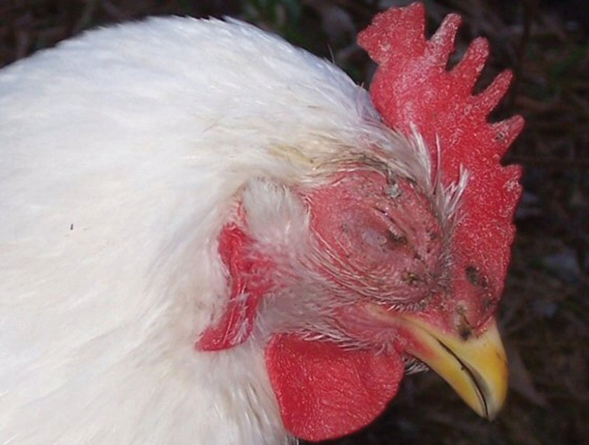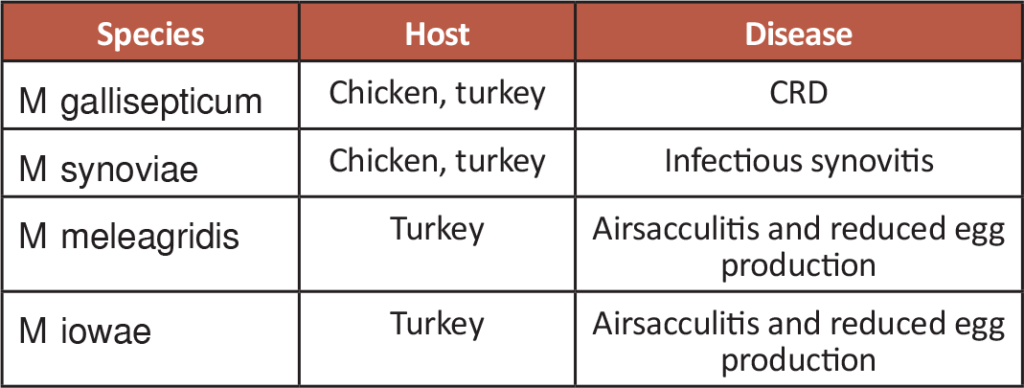Comprehensive Solutions for CRD & CCRD Without Antibiotics

Dr. Puja Hazra, Tresbien BioSynth Pvt. Ltd.
INTRODUCTION
Respiratory diseases are one of the biggest health challenges faced by poultry producers worldwide, with numerous virulent pathogens, both viral and bacterial and often seen in combination, threatening the industry’s flocks. Chronic respiratory disease (CRD), caused by Mycoplasma gallisepticum, is one of them. Mycoplasmas are bacteria that lack a cell wall, are small in size, and have the smallest genome among all independently replicating forms of life. CRD or CCRD (Complicated CRD ) or airsac disease is found everywhere and, though not a great killer, is extremely important to both layers and broilers. The disease is of great economic importance affecting egg production in layers and reducing growth in broilers.
CAUSATIVE AGENT
Mycoplasma posses very small genome and also they lack many metabolic pathways, so they require specific additional nutrient while grown in artificial media and are fastidious microorganisms. They grow at pH 7.8 and require 37 – 38˚C in a media containing 10-14% previously heat inactivated porcine serum. Their growth in the medium is identified by the change of medium colour of phenol red and dextrose from red to orange in 5 to 10 days. They grow slowly in broth and agar media (5–21 days). The organism forms small round colonies with a central nipple. These colonies typically look like “fried egg” under low magnification. The isolated colony ferments maltose and glucose but not dulcitol, lactose and salicin. More than 20 Mycoplasma species have been isolated from avian hosts; the pathogenic species are –

Mycoplasma meleagridis infection has been successfully eradicated from commercial turkeys, but the other 3 species still have economic importance. Each of these has distinctive epidemiologic and pathologic characteristics. Mycoplasmas do not survive for more than a few days outside the host. Most of the commonly used chemical disinfectants are effective against
M. gallisepticum.
SPREAD
MG infection is transmitted through the hatching egg. Vertical transmission is the major means of spread. M. gallisepticum does not survive more than a few days outside the host, so it needs carrier birds to spread the disease. If the organism gets protected by exudates, inflammatory material or in cold months, it may survive longer than usual outside host body. Approximately one out of 50 eggs laid by an infected hen contains this organism. A vertical transmission is done through the eggs of some unapparent carriers. The infected progeny transmits the agent horizontally via airborne route, by coughing or contaminated forage, water and environment to their co- hatchling. Infection mainly occurs through respiratory tract and conjunctiva. Farm workers and farm instruments are potential sources of cross contamination between houses.
COMPLICATED BY ASSOCIATIVE FACTOR
MG is characterized by respiratory symptoms and usually has a slower course of the disease. Hens and turkeys at all ages are susceptible, Although most outbreaks are seen in broiler chickens older than 4 weeks. This organism is present in all flocks but the disease is almost seen in flocks having bad management. There is certain associative factor which makes the flock more susceptible to CRD. Bacteria and virus causing respiratory infections like E. coli, P. multocida, H. paragallinarum and IB or ND viruses play associative role for the occurrence of CRD, commonly called as Complicated CRD (CCRD). The birds could carry the microorganism and be asymptomatic until the disease is triggered by stress factors such as sudden change of the premise, the diet or weather, vaccinations against or infections with IB or ND, increased levels of dust or ammonia. E. coli further aggravate the condition, by infecting airsacs which was previously infected by M. gallisepticum alone, or in combination with IB or RD virus.
SYMPTOM
The disease is more severe and plays longer duration in the months of winter. Also it affects younger birds more severely than mature birds. The most characteristic signs in adult flocks are sneezing, coughing, tracheal rales, nasal discharge open beak breathing. There is considerably less egg production as much as 50%, 7 -14 days post infection (Evans, R.D. et al., 1992, Avian Dis, 36; 956). Conjunctivitis, facial skin oedema, unilateral or bilateral swelling of periorbital sinuses and profuse tear secretion could be observed.
PATHOGNOMONIC FEATURE
The most important pathological feature is cloudy appearance of air sac. Air sac often contains cheesy exudates. Lymphoid follicles are formed in mucosa of trachea and air sacs and tubulo alveolar elongation of tracheal gland occur.
Some degree of pneumonia, pericarditis, perihepatitis could be seen in complicated cases. In the longer run air sac becomes dense and compacted.
DIAGNOSIS
- Signs of respiratory distress in growing birds and broilers, drop in egg production in layer birds.
- Cheesy inflammatory material in air sac.
TREATMENT & CONTROL MEASURE
As the organism gets transmitted through eggs, replacement of infected breeder stock and maintaining infection free birds are the best methods of handling this disease. There are several ways to kill the organism in the hatchling eggs and then the flock can be maintained free from the disease.
- Killing M. gallisepticum in hatching eggs
Eggs are incubated for 2-3 hours and then dipped in cold (2˚-5˚C) watery solution of antibiotic. The basic principle is expansion of egg content by heating to 37˚ to 38˚C and subsequent dipping in cold antibiotic solution causing shrinkage and entry of antibiotic solution in optimum concentration in egg that is sufficient to kill the organism.
Heat treatment is also done to kill the organism in hatching eggs. The eggs are kept at 46˚C for 12 to 14 hours, this heat is sufficient to kill M. gallisepticum, but not the chick embryo.
CRD is almost associated with bad management. Good ventilation should be maintained in poultry shed to reduce dust and ammonia as dusthelps in entry of both E. coli and Mycoplasma. The farm utensils and farm premises should be thoroughly cleaned by suitable disinfectant.
AMULET~CQR: A Potential Substitute of Antibiotic
Nowadays due to emergence of resistance against various antibiotics, there is a growing trend to substitute antibiotic usage by potential agents.
- AMULET~CQR is anovel combination of nanoencapsulated phytoextracts, nano silica, nano zinc and nano copper possessing bronchodilator, antitussive, expectorant & decongestant properties and can kill mycoplasma and other poultry respiratory viral pathogen.
- AMULET~CQR is useful for prevention and treatment of Chronic Respiratory Disease (CRD), Newcastle Disease(ND), Infectious Bronchitis(IB), Avian Influenza (AI), Infectious Laryngotracheitis (ILT), Infectious Coryza(IC) and associated symptoms viz cough, sneezing, nasal discharge, tracheal rales, gasping, unthriftiness etc.
COMPOSITION
- Nanoencapsulated Phytoextract – 76%
- Silca nanoparticles – 7%
- Zinc nanoparticles – 15%
- Copper nanoparticles – 2%
BENEFITS
- Water-soluble product
- Prevent the respiratory trouble of any aetiology
- For faster recovery from respiratory disorders
- Avoids the secondary complications in respiratory tract
DOSAGE
BROILER (For Prevention)
- On 18th–19th day – 5 ml per liter water
- On 23rd–24th day – 5 ml per liter water
BROILER (For Curation)
- 10 ml per liter water for 3 days
LAYER & BREEDER (For Prevention)
- After 4th week – 5 ml per liter water
LAYER & BREEDER (For Curation)
- 10 ml per liter water for 3 days
